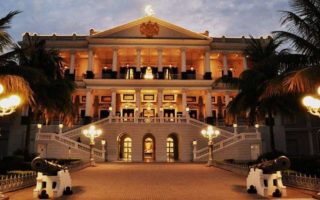Junagarh Fort, built in the fifteenth century in the city of Bikaner, has been calling all the history lovers since a very long time. It has been famous for its history and the enticing characteristics which depict the way royal families used to live.
Location
The Junagarh Fort is located in the Bikaner city of Rajasthan. The fort became the focal point around which the city was developed. This fort is one of the very few that have not been constructed over a hilltop.
History
Junagarh Fort was built by Karan Singh, who was appointed as the Prime Minister of Raja Rai Singhji, a ruler of Bikaner. The foundation of the fort was laid on February 17, 1589, and on January 17, 1594, the construction was complete. Raja Rai Singhji himself was a connoisseur of art and architecture and applied his knowledge skillfully to present a sample of excellence that reflects in the inner and outer structure of the fort.
Additions were made to the primary design of the fort in later years. Karan Singh built the Karan Mahal Palace during the period the Mughals were controlling the state. Anup Singh, another ruler, added new palaces along with a Zenana quarter, which was meant exclusively for the use of women of the royal family. He made a hall for the audiences who came to watch the court proceedings and named it Anup Mahal. Similarly, other rulers who conquered or inherited the kingdom made several additions to the fort.
Structure
The fort consists of several palaces and temples. It is a rectangular expanse with 14.5 feet wide and 40 feet high walls. A moat, now no longer in existence, surrounded the fort in its early days. Seven gates and thirty-seven bastions were constructed as a security measure against enemies trying to attack the kingdom. As you enter inside the fort, you will come across the Hindu and Jain temples, before your attention gets caught by the beautifully carved red and golden sandstones.
The entry to the fort was through the Karan Pol. Now, it is through the Suraj Pol or the Sun Gate. The gate faces east from where the sun rays fall on the gate, meant to be a lucky omen. It was through this gate that the emperors used to enter and exit with pomp and pose. Other gates of the fort are Daulat Pol, Chand Pol, and Fateh Pol. Har Mandir, a temple, was meant exclusively for the members of the royal family. This temple was a venue for worship, anniversary celebrations, festive celebrations, marriage, and all other events. A temple called Ratan Behari Mandir was made in 1846 near the fort. The different places inside the fort area:
Karan Mahal
This palace was built to mark the victory of Karan Singh against Aurangzeb, a ruler of the Mughal Dynasty. With beautiful stained glass windows and gardens, this palace is a true specimen of the aesthetics possessed by the rulers and architects. Several additions were made to this palace by the rulers in the later period, adding more to the appeal of the structure.
Phool Mahal
Phool Mahal translates to Flower Palace or the Palace of Flowers and is believed to be the oldest section of the fort.
Anup Mahal
It is the most opulent of all constructions inside the fort and served as the administrative headquarter to the king.
Chandra Mahal
It translates to Moon Palace. Here was the bedroom for the king or Maharaja, where mirrors had been placed in such a way that it was easy for king to see anyone approaching the bedroom.
Ganga Mahal
It is now a museum which exhibits the weapons used by the army. Among the various collections of this museum, there is an aircraft that had been used in the First World War and has been kept in good condition.
Badal Mahal
Several paintings, each depicting the chiefs from Shekhawat paying respect to the Maharaja wearing different types of turbans, have been put on show for the visitors here.
What to Do
Junagarh Fort Museum administered by “Maharaja Rai Singhji Trust” had been established in 1961 to enhance the appeal of the fort as a tourist spot. Inside the museum, you will come across several manuscripts in Sanskrit and Persian language. Apart from these manuscripts, there is a wide range of paintings, jewels, royal costumers, headgears, palanquins, war drums, and many other objects that are now a reminiscence of the times gone by.
Eat, Drink, Collect
The Bhujia of Bikaner, a crisp snack, which originated from the city itself, is a must have for the visitors. Head to the Bhujia Bazaar, Chai Patti, Chhappan Bhog, or Sankhla Kulfi are all famous spots in Bikaner city that serve a variety of snacks, meals, and beverages.
Best Time to Visit
The temperatures reach to the extreme during summer and winter season; while during the monsoon, very little rainfall is known to occur in this city. Therefore, visitors are advised to make necessary arrangements to be able to explore the fort and city area without facing much inconvenience due to the extreme climatic conditions.
How to Reach
Bikaner is well connected through road, rail, and air transport with other parts of the country. Several transportation modes are available according to your preferences. You can also hire bicycles from near the railway station. This way, you will be able to explore the city and the fort area by yourself while saving your precious time and money.
